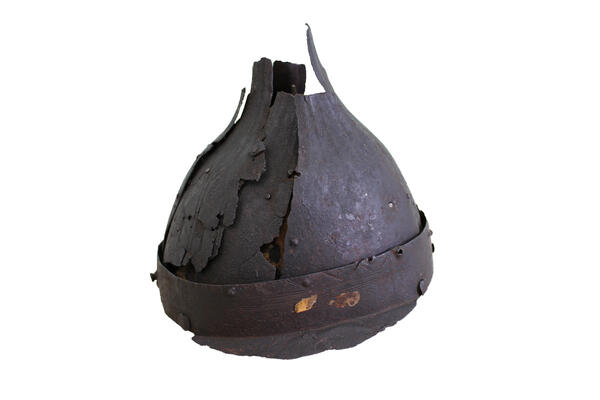Helmet — part of a warrior’s protective armament, designed to cover the head and neck from enemy attacks. European people in the early Middle Ages used frame helmets, and from the 10th century switched to the Norman-type nasal helmets. In Russia, in the 10th century, helmets of the Chernigov type of sphero-conical shape appeared, riveted from four parts. Under Russian influence, they spread to the West of Eastern Europe and replaced the Normans, because they provided more reliable protection from above attacks.
Such helmets, consisting of four parts, were use among the nomads — the shape was apparently borrowed from them. The appearance of high sphero-conical helmets in Russia in the XII century is also associated with the Eastern influence. At the same time, the nomads of Eastern Europe began to use cylindrical-conical helmets with a cutout for the face and equipped with a mask — in the XIV century in Russia they were modified into the so-called eastern bascinets.
In the XIV century, lobster-tailed pot helmets were first mentioned and then spread. In the XVI, iron hats appeared, and under Turkish and Iranian influence — the Misyurks and Erikhonkas. By the end of the century, low lobster-tailed pot helmets and hats almost completely replaced high helmets. A century later, under Western influence, European infantry helmets, in particular, cabassets, came to Russia. After the advent of firearms, armor gradually disappeared, and in the 18th century, soldiers already fought without helmets.
This specimen was found during the construction of the Yenisey — Ob canal (1882-1893) in the same grave as the chain mail displayed at the exhibition. The helmet was a gift to the Museum from Baron Bjork Alexis Aminov, who supervised the construction of the canal.
Such helmets, consisting of four parts, were use among the nomads — the shape was apparently borrowed from them. The appearance of high sphero-conical helmets in Russia in the XII century is also associated with the Eastern influence. At the same time, the nomads of Eastern Europe began to use cylindrical-conical helmets with a cutout for the face and equipped with a mask — in the XIV century in Russia they were modified into the so-called eastern bascinets.
In the XIV century, lobster-tailed pot helmets were first mentioned and then spread. In the XVI, iron hats appeared, and under Turkish and Iranian influence — the Misyurks and Erikhonkas. By the end of the century, low lobster-tailed pot helmets and hats almost completely replaced high helmets. A century later, under Western influence, European infantry helmets, in particular, cabassets, came to Russia. After the advent of firearms, armor gradually disappeared, and in the 18th century, soldiers already fought without helmets.
This helmet belongs to the cones, since at the base it is a hemisphere with an elevation on the top and a knob-like pommel. It consists of seven metal plates connected by rivets. Each plate is decorated with geometric ornaments. Also preserved are rivets for attaching a chain mail mesh-aventail (lost in this sample), which covered the warrior’s neck and consisted of the same rings as the chain mail. Probably, this helmet was worn not by the Cossacks, but by the local Yenisey Ostyaks or Tungus. This conclusion can be made based on the internal diameter of the helmet — it is less than 17 cm. The Yenisey Ostyaks and Tunguses belong to the Mongoloid race — their skull size is slightly smaller on average.
This specimen was found during the construction of the Yenisey — Ob canal (1882-1893) in the same grave as the chain mail displayed at the exhibition. The helmet was a gift to the Museum from Baron Bjork Alexis Aminov, who supervised the construction of the canal.



